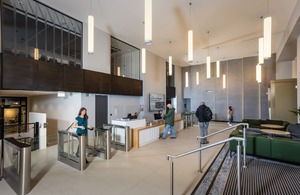Maintaining the privacy of occupancy data
The GPA's Head of Technology Allan Gardner discusses using occupancy data insights to make human-led decisions when managing government buildings.

Last week I was pleased to speak at the on the subject of using occupancy data insights to make human-led decisions when managing government buildings.
It was great to have the opportunity to talk to an audience who were keen to hear about our property technology. Some didn鈥檛 realise that the Government Property Agency (the GPA) is landlord for a ten million square metre government property portfolio; that we manage the hubs programme; and that we鈥檙e responsible for refurbishing, modernising and rationalising the office estate in Whitehall to maximise its efficiency.聽
I also explained what we mean by 鈥榠nteroperability鈥� 鈥� making it easier for civil servants to work from wherever they need to be (mostly within the government estate, but beyond that as well) and for civil servants from different departments to work together.
What occupancy data tells us
The focus for my presentation was occupancy monitoring, which has been quite the journey. We鈥檝e done a lot of work on what we wanted to understand from monitoring occupancy. Recently we reached a milestone of one million square metres of occupancy data collected and that data helps us deliver a better workplace by getting objective feedback on what works well and what doesn鈥檛.聽
Data enables us to improve facilities management and understand consumption of resources; design comfortable and safe spaces to work; and give our people a better experience. It helps us make better strategic decisions and manage our portfolio of property so we have the right size of estate.聽
Diverse systems
With occupancy monitoring we鈥檙e trying to understand how many people are in all our buildings but this is across a large and varied estate 鈥� around 400 different departments and other organisations, all with IT teams and not necessarily using our technology.聽
We鈥檝e looked at various ways for collecting data and our clients do share data they have but it鈥檚 often from diverse access systems. So far there hasn鈥檛 been one route to data collection that works for all.
Human-led decisions
It鈥檚 about using data-powered insights to make human-led decisions. We鈥檙e looking to unlock occupancy technology to give us the data we need, now and for the future.聽
Our plan is to focus on open standards and a more open messaging architecture at the heart which will collect data at building level and ship, filter and aggregate at the enterprise level. When we need to make changes this will mean less costly rework; it will offer a more open playing field for both providers and consumers of the data; and it will give us more control of聽 where the data goes in order to respect people鈥檚 privacy and manage our security risk.
We鈥檒l be able to explore new ways of sharing data with our clients, helping them to manage how their buildings are being used and gain benefits from the insights the data reveals. The aim is to deliver the best value for our clients and the most effective and productive spaces for our customers. All while saving costs for the taxpayer.
For more information email [email protected]